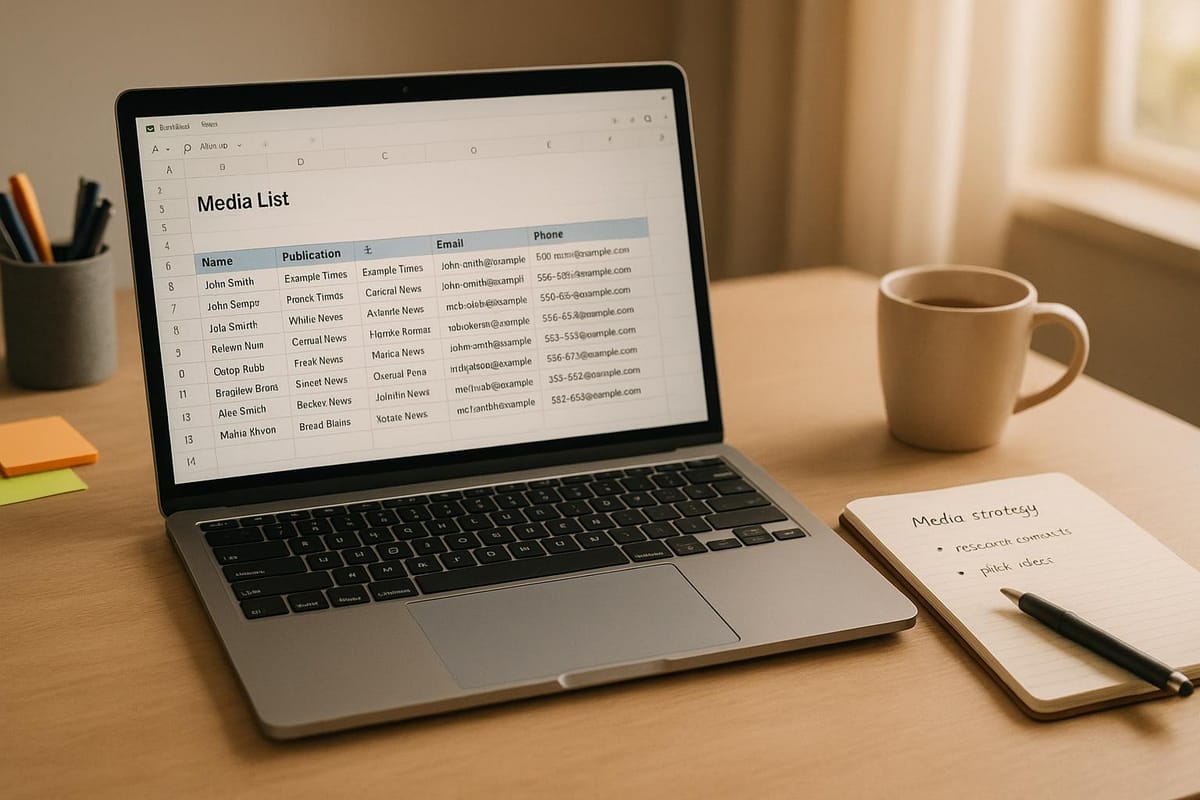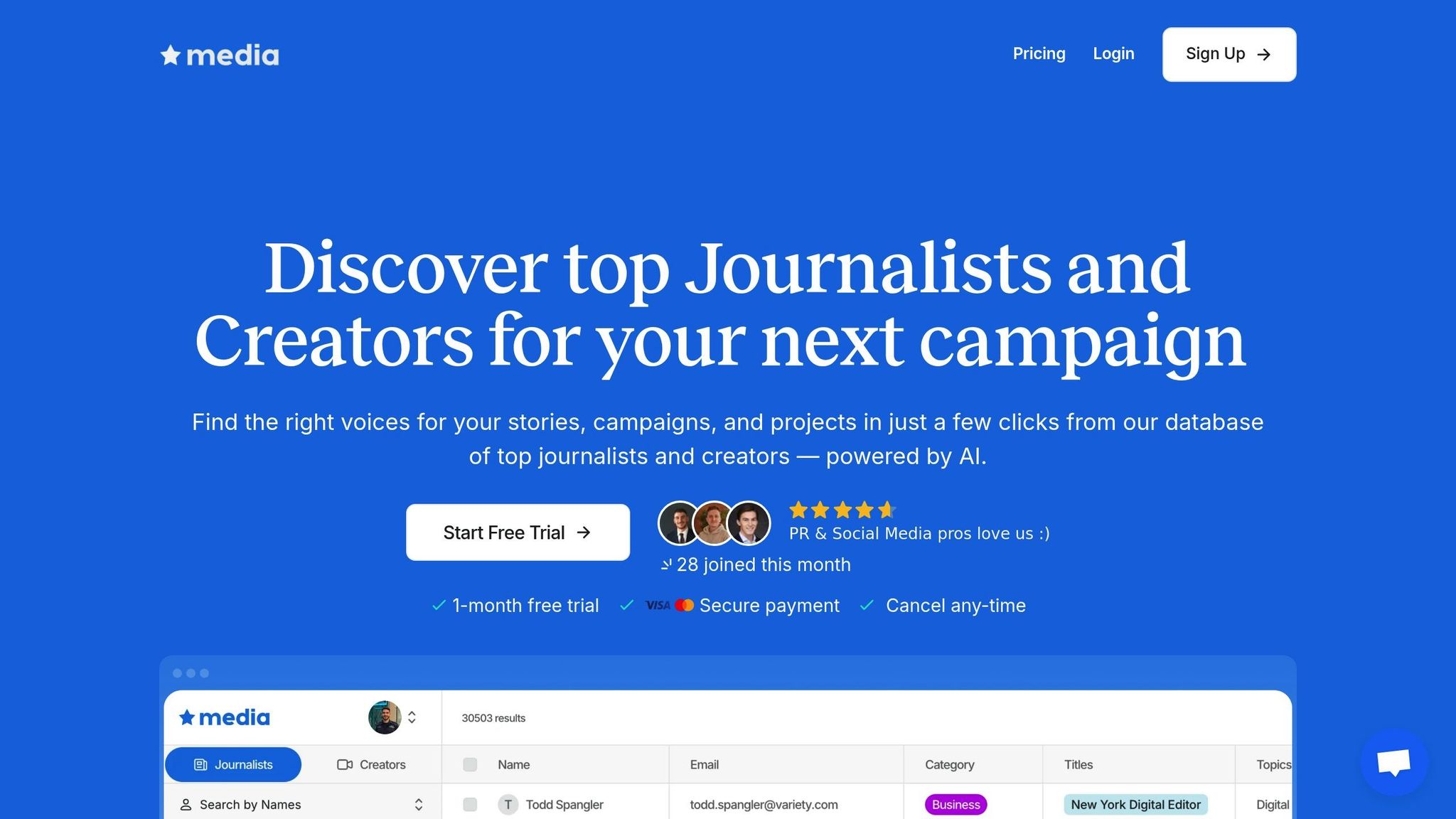How to Build Media Lists That Get Results
Learn how to create targeted media lists that enhance PR outreach, increase journalist engagement, and deliver measurable results.

Creating a media list is one of the most important steps in any PR campaign. A well-targeted list ensures your story reaches the right journalists, increasing your chances of coverage. Here’s what you need to know upfront:
- Why it Matters: Journalists get flooded with pitches, and only 25% are relevant to their interests. A targeted list improves response rates by up to 30%.
- Key Features of a Good Media List:
- Relevance: Only include contacts who cover your industry or topic.
- Accuracy: Keep contact info up-to-date to avoid wasted effort.
- Segmentation: Group contacts by niche or audience for tailored outreach.
- Personalization: Include details like recent work and preferred topics.
- Tools Like Media AI: Platforms like Media AI save time by automating research, offering a database of over 30,000 journalists, and ensuring your list stays current.
What Makes a Media List Work
Media Lists Defined: Purpose and Impact
A media list is a carefully compiled database of media contacts relevant to your business or industry, including journalists, bloggers, podcasters, and influencers. Think of it as your blueprint for reaching the right people who can amplify your story. It helps you conduct targeted research, define your audience, and build meaningful relationships.
This approach is especially critical in today's media landscape, where only 7% of journalists say the pitches they receive are relevant to their audience. That statistic highlights a huge opportunity: by focusing on that 7%, you avoid getting lost in the sea of irrelevant pitches filling inboxes.
"If you want to get quality coverage, you need to thoroughly research your target journalists, and invest time in building unique, tailored media lists. Buying generic journalist lists won't cut it in 2024." - Tayla Davie, Digital PR Manager, NORTH
Traits of High-Performing Media Lists
The effectiveness of a media list boils down to four key traits: relevance, accuracy, segmentation, and personalization.
Relevance is non-negotiable. Your list should include only those contacts who cover topics directly tied to your pitch or campaign. Why? Because nearly half of PR pitches are ignored, with 73% failing due to lack of relevance. A focused list ensures your efforts aren't wasted on the wrong people.
Accuracy is the backbone of effective outreach. An outdated list means your emails could end up in the wrong inbox - or no inbox at all. Regular updates ensure you're connecting with the right journalists who are still active in your field.
"90% of managing a media list is updating it." - Berenika Teter, Writing about coworking & hybrid spaces
Segmentation allows for precision targeting. By organizing contacts into groups based on their niche, angle, or area of expertise, you can craft pitches that resonate more deeply with specific audiences.
Personalization turns a cold pitch into a warm introduction. A strong media list includes detailed insights about each contact, such as their preferred topics, recent work, and how they like to be pitched. Here's a quick breakdown of the essentials:
| Essential Media List Information | Description |
|---|---|
| Contact details | Email address |
| Full name | Journalist's full name |
| Outlets | Publications they contribute to |
| Role | Reporter, editor, or other |
| Beats and topics covered | Examples: nutrition, CrossFit, paleo |
| Social media handles | Twitter, LinkedIn profiles |
| Relevant past content | Recent articles or coverage |
For advanced lists, you can go even further by including details like recently updated contact info, publishing frequency, performance metrics, content tone, emotional appeal, pitch preferences, location, time zone, languages spoken, and additional notes. Some lists even rank contacts based on metrics like organic traffic, trust score, or domain authority, helping you prioritize your outreach.
While building a media list takes more time than simply buying a pre-made database, the payoff is worth it. By emphasizing relevance, accuracy, segmentation, and personalization, you can create a media list that cuts through the noise and connects you with the journalists who truly matter for your goals.
Next, we’ll explore how to choose the right contacts for your outreach strategy.
How to Find the Right Journalists and Creators
Selection Criteria for Journalists and Creators
Finding the right journalists and creators starts with understanding your target audience and aligning your outreach with your campaign goals. This step is crucial for building a media list that delivers results. Before diving into contact selection, be clear on who you want to reach and the story you aim to tell.
Your campaign objectives will guide your strategy. Are you introducing a new product, aiming to boost brand visibility, or sharing news about a funding round? Each goal calls for a different set of media contacts. For instance, a tech startup announcing Series A funding would benefit from connecting with business reporters who cover venture capital. On the other hand, a consumer brand launching a new product might focus on lifestyle bloggers or product reviewers. Keep in mind that engaging with premium publications or top-tier influencers often requires more resources.
When narrowing down your list, focus on three core factors: industry relevance, audience alignment, and engagement quality.
- Industry relevance: Target professionals who regularly cover your field. For example, a fintech company should avoid pitching to food bloggers, no matter how large their audience. Review their recent articles, social media activity, and content themes to ensure they’re a good fit.
- Audience alignment: Make sure their audience matches your target demographics in terms of age, location, interests, and purchasing behavior. For example, a B2B software company should prioritize contacts whose followers include IT professionals or decision-makers rather than general consumers.
- Engagement quality: A smaller, highly engaged audience is often more impactful than a larger, passive one. A creator with 10,000 engaged followers in your niche can outperform another with 100,000 disengaged followers. Look for active interactions like comments, shares, and discussions.
Geographic focus is another key consideration, especially for campaigns tied to specific locations. If you’re targeting certain U.S. markets, prioritize local media outlets and influencers who understand the local audience and preferences. While national outlets can provide broad coverage, local contacts often deliver more tailored and relevant reach.
Additionally, study each contact’s content style. Some journalists lean toward data-driven stories, while others prefer human interest pieces. Similarly, creators may favor video content, product demonstrations, or traditional reviews.
To refine your approach, define 3–5 core messages that resonate with your audience’s priorities. Whether your campaign focuses on themes like sustainability, innovation, or cost savings, these messages will help you identify contacts who naturally cover similar topics.
With these criteria in mind, you can streamline your research further using tools like Media AI.
Using Media AI to Speed Up Contact Selection

Selecting the right contacts can be time-consuming, but Media AI simplifies the process by turning what was once a tedious task into an efficient workflow. Instead of manually searching through endless publications and profiles, you can use its advanced features to quickly identify the most relevant contacts for your U.S.-based campaigns.
Media AI offers advanced filtering and export options that let you refine your search based on multiple factors - like industry focus, geographic location, outlet type, and audience size. For example, if you’re launching a healthcare app in California, you can filter for health and wellness journalists on the West Coast writing for digital outlets that cater to health tech enthusiasts.
The platform also provides real-time database updates, ensuring your contact information is always current. This means you won’t waste time pitching journalists who have moved to different beats or publications.
Its search tools go beyond simple keyword matching. You can look for contacts based on recent coverage topics, allowing you to find journalists who have written about subjects relevant to your campaign in the last few months. This approach improves your chances of relevance and response.
Media AI also helps you customize your pitches. Detailed contact profiles include insights like recent articles, preferred topics, and content style, enabling you to craft personalized messages that stand out from generic outreach.
Building Media Lists with Media AI
Step-by-Step Media AI Guide
Using Media AI to build your media list turns what used to be a tedious process into something quick and efficient. With access to a database of over 30,000 journalists and creators, the platform makes it easier to create focused lists that actually work.
Before diving in, set clear campaign goals. Think about your target audience, campaign objectives, and geographic focus. This groundwork helps you fully leverage Media AI's powerful filters.
Once you're in the platform, you'll find an intuitive search interface paired with an always-up-to-date database of contacts.
- Filter by industry to zero in on journalists who specialize in areas like fintech, healthcare, consumer goods, or technology.
- Use geographic filters to pinpoint national, regional, or local markets within the U.S.
- Add keyword filters to find contacts who’ve recently covered topics relevant to your campaign.
Media AI’s AI-powered recommendations take things a step further by suggesting additional journalists or creators whose work aligns with your campaign focus, ensuring you don’t miss key opportunities.
For each contact, you can review their recent articles, preferred topics, and audience insights to confirm their relevance. Once your list is finalized, export it as a CSV file. The export includes everything you need - email addresses, social handles, recent coverage, and audience demographics - ready to use for your outreach.
This streamlined workflow saves you hours compared to traditional research, leaving you more time to craft personalized pitches and refine your campaign strategy.
How to Organize Media Lists for Better Results
Once you’ve exported your contacts, organizing them effectively is key to maximizing your outreach. A well-structured media list isn’t just a collection of names; it’s a tool that drives strategic and targeted communication.
Start by segmenting your contacts into tiers. For example:
- Tier-one: Major outlets and top influencers
- Tier-two: Regional publications and mid-level contacts
- Tier-three: Niche or emerging voices
This structure ensures you focus your energy where it matters most - personalizing pitches for high-priority contacts while using templates for broader outreach.
If you’re juggling multiple campaigns, group contacts by themes. For instance, if you’re announcing a new product and celebrating a company milestone, create separate sections for product reviewers, business journalists, and industry analysts. This keeps your outreach organized and avoids sending the wrong pitch to the wrong person.
For campaigns targeting specific U.S. regions, segment by location. This not only helps you tailor your messaging to local audiences but also makes it easier to manage outreach across different time zones.
Add campaign-specific notes to your list. Include columns for pitch status, follow-up dates, and any prior interactions with each contact. Tracking details like preferred communication methods and recent coverage topics ensures your team stays consistent and avoids duplicate outreach.
To keep things moving smoothly, create workflow stages within your list. Categories like "Ready to Pitch", "Pitched - Awaiting Response", "Follow-up Needed", and "Completed" help teams stay on top of tasks and ensure no contact is overlooked during busy campaigns.
When working with creators, think about audience overlap instead of just follower counts. A micro-influencer with a small but highly engaged audience can often deliver better results than a larger influencer with a less focused following.
Lastly, separate your lists by content type. Journalists covering breaking news have different needs than those writing feature stories, and creators specializing in video content require a different approach than those writing blogs. Matching your outreach to their preferred format and timeline increases your chances of success.
Don’t forget to keep your list updated. Review it monthly to remove contacts who’ve changed roles or publications and add new ones from Media AI’s ever-growing database. This ensures your outreach remains relevant and effective.
Measuring and Improving Your Media List Performance
How to Track Media List Success
Tracking the performance of your media list is essential for getting the most out of your outreach efforts and boosting your campaign ROI. Without proper measurement, you could miss opportunities to fine-tune your strategy and achieve better results.
Start by keeping an eye on brand mentions across all active channels. Measure how often your brand, product, or service is mentioned during specific campaign periods. This helps you understand your overall reach and identify which contacts are actively covering your story and how far it's spreading.
Engagement metrics are another critical piece of the puzzle. These metrics show how well your campaign connects with audiences. To calculate engagement rate, use the formula: (interactions ÷ total reach) × 100. This helps pinpoint which journalists and creators are sparking meaningful conversations about your brand.
Here’s an eye-opener: Organizations that leverage customer insights see 85% higher sales growth and over 25% higher gross margins.
Key Performance Indicators (KPIs) to Track:
- Placement Rate: Measure how many of your pitched contacts publish or share content about your campaign.
- Click-Through Rate (CTR): Keep tabs on how often people click on links in articles or social posts to access your content. A high CTR signals that your story is compelling.
- Conversion Rate: Evaluate how often media coverage leads to actions like website visits, downloads, or sales. This shows the direct business impact of your media list.
- Share of Voice: Compare your brand’s share of relevant industry conversations to competitors to gauge visibility and influence.
- Sentiment Analysis: Assess whether mentions are positive, neutral, or negative. This helps you identify contacts who consistently provide favorable coverage.
Additionally, track traffic sources to see which publications and creators are driving valuable visitors to your site. Metrics like new visitors, total sessions, referral sources, and time spent on your site can give you a clearer picture of what’s working. Use this data to fine-tune your strategies and focus on what delivers the best results.
Using Data to Improve Future Media Lists
Performance data isn’t just for tracking - it’s a powerful tool for improving your future efforts. By analyzing past results, you can identify elements that worked well and areas where your media list could be more effective.
Segment your data and experiment with A/B testing to uncover the highest-performing contact groups. Factors like contact type, publication tier, and geographic region can reveal patterns. For example, you might find that certain segments consistently drive higher engagement.
Long-term success can also be measured through audience growth rate. This metric tracks how many people become loyal followers or customers after encountering your media coverage. Use the formula: ((post - pre) ÷ pre) × 100 to calculate growth.
Media AI’s database can be a game-changer here. It helps you find new contacts who share traits with your top-performing journalists and creators.
"Personalized calls-to-action convert 202% better than generic ones, according to HubSpot research".
Take this insight to heart by crafting targeted contact segments based on past performance. Tailored outreach often leads to better results.
Pay close attention to conversion points to identify which contacts are generating the most coverage and conversions. This allows you to prioritize relationships with journalists and creators who consistently deliver high-value audiences.
Make it a habit to review your media list performance regularly. Update your contact list based on successful profiles, and take advantage of tools like Media AI’s updated database to discover fresh, promising contacts. The goal is to turn your media list into a dynamic, evolving resource that gets smarter and more effective with every campaign.
Why Your Media List Sucks (And How To Build One Like A PR Pro)
Conclusion: Better Results Through Targeted Media Lists
Creating effective media lists goes beyond simply gathering contacts - it's about laying down a strategic framework that delivers impactful results for your PR and marketing efforts. The real distinction between a generic list and a high-performing one lies in focused outreach that connects your message with the right journalists and creators at just the right time.
As mentioned earlier, targeted outreach is the cornerstone of measurable PR success. By 2026, 80% of PR professionals are expected to rely on AI tools to streamline their efforts. Yet, only 22% of communications leaders feel confident in their teams' ability to connect with the right media partners. This highlights a growing gap between the demands of modern PR and the limitations of traditional methods.
With tools like Media AI, you can automate time-consuming tasks, ensuring your media lists adapt to the ever-changing demands of your campaigns. This approach not only saves hours of manual effort but also makes your outreach more precise and impactful.
Journalists appreciate this precision, too. In fact, 74% of them say communicators who understand their audience make their jobs easier. Well-targeted lists don’t just boost your chances of coverage - they also help journalists by delivering relevant, meaningful pitches.
AI takes it a step further by keeping your media lists up to date. It identifies inactive contacts, adds new ones as the media landscape evolves, and ensures your lists stay fresh without constant manual intervention. This dynamic updating process allows you to focus on refining your outreach strategy with expert insights.
The winning formula combines AI-driven tools with human expertise. Media AI's database of over 30,000 journalists and creators helps you find the right contacts, while your strategic know-how ensures pitches are personalized and relevant. Considering that three out of four journalists block irrelevant or spammy pitches, precision is non-negotiable.
Your media list should grow and adapt with each campaign. By using AI to handle repetitive tasks and analyzing performance data to fine-tune your approach, you create a system that becomes more effective with every use. Pair these insights with proven outreach tactics, and you'll see better coverage, stronger relationships, and measurable results for your business.
FAQs
How can I keep my media list accurate and up-to-date to avoid pitching to inactive contacts?
Keeping your media list up to date is crucial for effective outreach. Regularly review it by removing outdated contacts, verifying email addresses, and updating details as needed. Tools like Media AI can simplify this process by automating updates, tracking engagement, and ensuring your list remains relevant.
It’s also smart to cross-check your list against recent activities, such as published articles or social media updates, to confirm your contacts are still active and aligned with your campaign objectives. A well-maintained list not only saves time but also boosts the success of your outreach efforts.
What are the advantages of using AI tools like Media AI to create and manage media lists?
Using AI tools like Media AI to create and manage media lists can transform how PR teams approach outreach. These tools simplify the process by automating the search for relevant journalists and influencers, cutting down on time and effort while boosting precision. Plus, they tap into real-time data, allowing you to tweak your outreach strategies to align with current trends and journalist activity - keeping your campaigns sharp and effective.
AI-powered platforms also bring a new level of efficiency and flexibility, enabling you to craft highly targeted media lists tailored to your campaign goals. This means PR professionals can spend less time on repetitive tasks and more time building genuine relationships, leading to stronger engagement and better results.
How can I evaluate the effectiveness of my media list and improve future outreach efforts?
To determine how effective your media list is, pay attention to metrics like media mentions, audience reach, and engagement rates (such as website traffic or social media activity). These numbers can give you a clear picture of how well your list supports your campaign objectives.
It’s also important to evaluate the quality and relevance of your media contacts. Keep an eye on response rates and look at the results of any media coverage you’ve secured. By regularly analyzing this data, you can fine-tune your list and sharpen your targeting for future efforts. When your outreach is aligned with clear, measurable goals, it’s much easier to adjust and improve your strategy over time.





